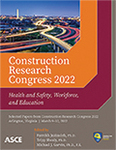Impact of Green Construction on Safety Performance in the Built Environment
Publication: Construction Research Congress 2022
ABSTRACT
Worker health and safety remains to be of high concern throughout the construction industry. Multiple innovative methods and practices have been developed in order to enhance worker health and safety in the construction industry. Green construction is one of the innovations that is expected to enhance worker health and safety. The aim of this research study is to investigate the impact of green construction on safety performance in the construction industry. It is hypothesized that green construction positively influences worker health and safety and is, therefore, associated with fewer workplace incidents compared with traditional, non-green construction. To test this hypothesis, a survey questionnaire is developed and distributed to project managers to collect incident data from green and non-green construction projects. After collecting the data, statistical analysis is performed to determine the impact of green construction on safety performance. Results from the study indicate that there is no statistical evidence in support of the research hypothesis that green construction is associated with reduced incident rates. Recommendations to facilitate the integration of workplace health and safety in sustainable design and construction are provided. It is expected that this integration would be associated with improved working conditions and fewer incidents.
Get full access to this article
View all available purchase options and get full access to this chapter.
REFERENCES
Abowitz, D. A., and Toole, T. M. (2010). Mixed method research: Fundamental issues of design, validity, and reliability in construction research. J. Constr. Eng. Manage., 136(1), 108–116.
Al-Bayati, A. J., Bilal, G. A., Esmaeili, B., Karakhan, A., and York, D. (2021). Evaluating OSHA’s fatality and catastrophe investigation summaries: Arc flash focus. Safety science, 140, 105287.
Bayraktar, M., and Owens, C. (2010). LEED implementation guide for construction practitioners. J. Archit. Eng., 16(3), 85–93.
Behm, M. (2012). Safe design suggestions for vegetated roofs. J. Constr. Eng. Manage., 138(8), 999–1003.
BLS (Bureau of Labor Statistics). (2020). Injuries, illnesses, and fatalities. <https://www.bls.gov/iif/#:~:text=A%20total%20of%205%2C333%20workers,the%20rate%20reported%20in%202018>(Mar. 18, 2021).
CDC (Centers for Disease Control and Prevention). (2004). Preventing falls of workers through skylights and roof and floor openings. <https://www.cdc.gov/niosh/docs/2004-156/pdfs/2004-156.pdf>(May 30, 2021).
Dewlaney, K., Hallowell, M., and Fortunato, B., III. (2012). Safety risk quantification for high performance sustainable building construction. J. Constr. Eng. Manage.,138(8), 964–971.
Fortunato, B., Hallowell, M., Behm, M., and Dewlaney, K. (2012). Identification of safety risks for high-performance sustainable construction projects. J. Constr. Eng. Manage., 138(4), 499–508.
Gambatese, J., Rajendran, S., and Behm, M. (2007). Green design and construction: Understanding the effect on construction worker health and safety. Prof. Saf., 52(5), 28–35.
Hallowell, M., Hinze, J., Baud, K., and Wehle, A. (2013). Proactive construction safety control: Measuring, monitoring, and responding to safety leading indicators. J. Constr. Eng. Manage., 139(10), 04013010.
Hinze, J., and Gambatese, J. (2003). Factors that influence safety performance of specialty contractors. J. Constr. Eng. Manage., 129(2), 159–164.
Hinze, J., Godfrey, R., and Sullivan, J. (2013). Integration of construction worker health and safety in assessment of sustainable construction. J. Constr. Eng. Manage., 139(6), 594–600.
Huang, X., and Hinze, J. (2006). Owner’s role in construction safety. J. Constr. Eng. Manage., 132(2), 164–173.
Kamas, W. M., Hasan, A. A., and Fadel, A. H. (2019). Economic Benefits for the Application of Standards of Sustainability in Construction Projects. Journal of Engineering, 25(3), 117–126.
Karakhan, A. A., and Gambatese, J. A. (2017a). Identification, quantification, and classification of potential safety risk for sustainable construction in the United States. J. Constr. Eng. Manage., 143(7), 04017018.
Karakhan, A. A., and Gambatese, J. A. (2017b). Safety Innovation and Integration in High-Performance Designs: Benefits, Motivations, and Obstacles. Practice Periodical on Structural Design and Construction, 22(4), 04017018.
Karakhan, A., Rajendran, S., and Gambatese, J. (2018). Validation of time-safety influence curve using empirical safety and injury data—Poisson Regression. In Construction Research Congress 2018: Safety and disaster management (389–399). New Orleans, LA: American Society of Civil Engineers (ASCE).
Marjaba, G., and Chidiac, S. (2016). Sustainability and resiliency metrics for buildings critical review. Build. Environ., 101, 116–125.
McCon, P. E. (1997). Housekeeping & injury rate: A correlation study. Prof. Saf., 42(12), 29–30.
Mitchell, D. (2018). Overview of Survey Anonymity and Confidentiality. <https://www.mesacc.edu/sites/default/files/pages/about-mcc/institutional-effectiveness/Overview-MCC-OIE-Survey-Anonymity-and-Confidentiality.pdf>(April 23, 2021).
NIOSH (National Institute for Occupational Health and Safety). (2011). Integrating occupational health and safety into the U.S. green building council LEED new construction credits: A preliminary report. Washington, DC.
Rajendran, S., Gambatese, J. A., and Behm, M. G. (2009). Impact of green building design and construction on worker safety and health. J. Constr. Eng. Manage., 135(10), 1058–1066.
Ramsey, F., and Schafer, D. (2013). The statistical sleuth: A course in methods of data analysis. 3rd Edition, Cengage Learning, Boston, MA.
Silins, N. (2009). Green has come of age.” Prof. Saf., 54(3), 46–49.
USGBC (US Green Building Council). (2014). LEED 2009 for new construction and major renovations.” <http://www.usgbc.org/resources/leed-new-construction-v2009-current-version>(Mar. 18, 2021).
USGBC (US Green Building Council). (2015). Better buildings are our legacy. 〈http://www.usgbc.org/leed〉 (Mar. 18, 2021).
Valdes-Vasquez, R., and Klotz, L. E. (2013). Social sustainability considerations during planning and design: Framework of processes for construction projects. J. Constr. Eng. Manage., 139(1), 80–89.
Information & Authors
Information
Published In
History
Published online: Mar 7, 2022
Authors
Metrics & Citations
Metrics
Citations
Download citation
If you have the appropriate software installed, you can download article citation data to the citation manager of your choice. Simply select your manager software from the list below and click Download.
